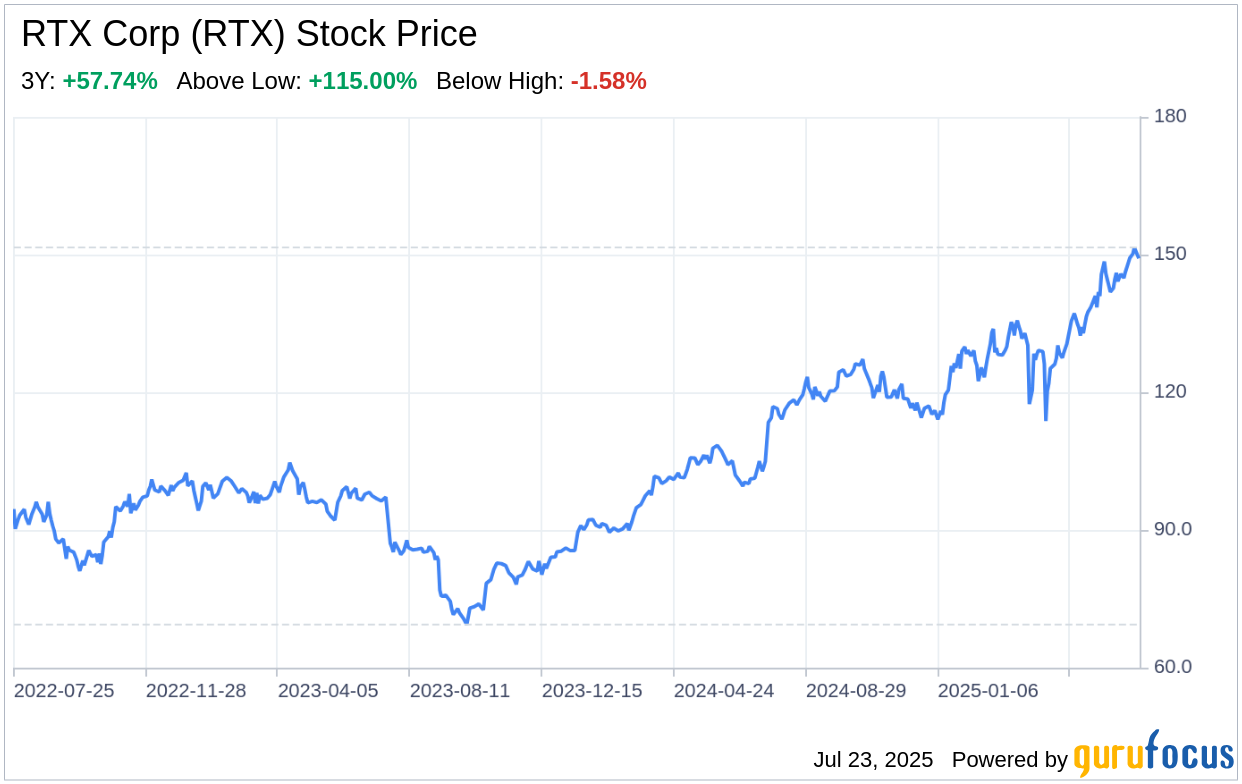RTX Corp (RTX, Financial), an aerospace and defense manufacturer, has released its 10-Q filing dated July 22, 2025, providing a detailed financial overview and insights into its operational performance. The company, formed from the merger of United Technologies and Raytheon, operates through three segments: Collins Aerospace, Pratt & Whitney, and Raytheon. The recent financial tables reveal a significant year-over-year increase in net income, from $175 million in Q2 2024 to $1,725 million in Q2 2025, and a rise in total net sales from $19,721 million to $21,581 million for the same period. This robust financial performance underscores RTX's strong market position and operational efficiency.

Strengths
Brand Power and Market Position: RTX Corp (RTX, Financial) stands out in the aerospace and defense industry with a strong brand presence and a diversified portfolio. The company's financial performance, as indicated by the recent 10-Q filing, showcases a substantial increase in net income from $175 million in Q2 2024 to $1,725 million in Q2 2025. This financial robustness is a testament to RTX's market position and its ability to deliver high-quality products and services. The company's three segments, Collins Aerospace, Pratt & Whitney, and Raytheon, each contribute to a comprehensive offering that spans commercial aerospace and defense markets, providing RTX with a competitive edge and resilience against market fluctuations.
Technological Innovation: RTX Corp (RTX, Financial) is at the forefront of technological innovation within the aerospace and defense sectors. The company's commitment to research and development, as evidenced by its $697 million investment in Q2 2025, drives its ability to offer cutting-edge solutions. This focus on innovation not only enhances RTX's product offerings but also positions the company as a leader in developing new technologies that meet the evolving needs of its global customer base. The technological advancements contribute to RTX's strengths by enabling it to secure and maintain long-term contracts, as reflected in its $236 billion Remaining Performance Obligations (RPO).
Weaknesses
Supply Chain and Operational Risks: Despite its strong market position, RTX Corp (RTX, Financial) faces challenges related to supply chain management and operational risks. The global trade environment, with its dynamic tariffs and countermeasures, poses a threat to RTX's supply chain efficiency. The company's reliance on global suppliers and the need to import goods subject to tariffs can lead to increased costs and potential disruptions. While RTX has strategies in place to mitigate these risks, such as seeking exemptions and evaluating supply chain changes, the impact of these pressures remains uncertain and could affect the company's cost structure and competitive advantage.
Regulatory and Compliance Burdens: RTX Corp (RTX, Financial) operates in a highly regulated industry, where compliance with government regulations is critical. The company's involvement in international markets requires adherence to various U.S. and foreign government policies, which can be subject to change. Regulatory approvals, such as those for foreign military sales, are essential for RTX's operations but can be delayed or revoked, potentially impacting financial results. Additionally, the company must navigate complex tax legislation, such as the Act enacted on July 4th, 2025, which, while not significantly impacting RTX's tax expense and cash flows for 2025, adds to the compliance burden and requires ongoing evaluation of its financial implications.
Opportunities
Global Defense Spending: RTX Corp (RTX, Financial) is well-positioned to capitalize on the increasing global defense spending, particularly in light of geopolitical tensions and the emphasis on national security. The company's Raytheon segment, with its expertise in missile defense systems and sensors, stands to benefit from initiatives like the U.S. government's Iron Dome for America executive order, which allocates $24.4 billion for a next-generation missile defense shield. RTX's advanced technologies align with these defense priorities, presenting significant opportunities for growth and expansion in the defense market.
Commercial Aerospace Recovery: As the commercial aerospace industry recovers from the impacts of the global pandemic, RTX Corp (RTX, Financial) has the opportunity to leverage its Pratt & Whitney and Collins Aerospace segments to meet the rising demand for commercial aircraft and services. The company's strong presence in both OEM and aftermarket parts and services positions it to benefit from the industry's resurgence. With air travel expected to continue its upward trajectory, RTX can expect increased demand for its engines, components, and maintenance services, driving revenue growth and market share expansion.
Threats
Geopolitical Instability and Trade Policies: RTX Corp (RTX, Financial) operates in a volatile global environment where geopolitical instability and trade policies can significantly impact its business. The ongoing tensions between the U.S. and countries like Russia and China, coupled with sanctions and export controls, pose risks to RTX's international operations and supply chain. The company must navigate these complexities while maintaining compliance and managing potential disruptions to its business. Although RTX has not experienced material adverse effects to date, the situation remains fluid, and future developments could pose greater threats to the company's financial performance and strategic objectives.
Economic Uncertainty and Market Volatility: The macroeconomic environment presents a threat to RTX Corp (RTX, Financial), as economic uncertainty, interest rate fluctuations, and financial market volatility can affect demand for its products and services. The company's operations are sensitive to changes in global trade
This article, generated by GuruFocus, is designed to provide general insights and is not tailored financial advice. Our commentary is rooted in historical data and analyst projections, utilizing an impartial methodology, and is not intended to serve as specific investment guidance. It does not formulate a recommendation to purchase or divest any stock and does not consider individual investment objectives or financial circumstances. Our objective is to deliver long-term, fundamental data-driven analysis. Be aware that our analysis might not incorporate the most recent, price-sensitive company announcements or qualitative information. GuruFocus holds no position in the stocks mentioned herein.
